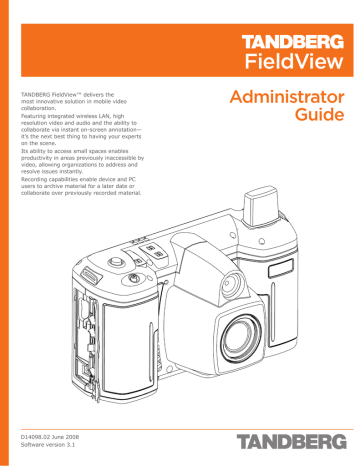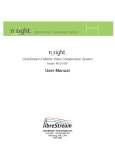advertisement

Chapter 3 TANDBERG FieldView Administrator Guide
Wireless Coverage
Range achievable over the 802.11b/g WLAN interface can vary from hundreds of meters under near ideal conditions down to much shorter distances under challenging conditions. Coverage area can vary dramatically depending on a variety of factors, including:
• Topography
• Walls, dividers, windows, ceilings, floors, etc.
• Radio-reflective materials (may cause attenuation and/or multi-path reflections)
• Interference and noise
• Access point and antenna mounting location
• Antenna type and orientation
• TANDBERG FieldView Device orientation
• Network traffic
• Number of connected devices
Fig. 3-2 Wireless Coverage Map (Aerial
View).
Effect of Topography on Coverage
Fig. 3-2 shows an aerial view of a simple floor plan with a single access point
(denoted as AP). The dark blue shaded area indicates the coverage pattern that the access point provides for this site. The building’s walls and dividers act as attenuators for the signal, shaping the coverage pattern as shown.
Signal to Noise Ratio
Achievable range is directly related to the quality of the signal received by the TANDBERG FieldView Device. The quality is a factor of the radio signal strength, which is affected by attenuators such as the topographic features listed above and the air itself, and the interference and noise level.
As the noise level approaches the level of the desired received signal, the quality will suffer. To increase usable range, noise must be kept to a minimum and signal strength must be used to overcome the remaining noise level (there is always some level of background noise). The usual measure of signal quality is Signal-to–Noise Ratio (SNR) which is illustrated in Fig. 3-3 with a simplified signal.
The TANDBERG FieldView Device provides received signal strength and
SNR information that can be used to assist with range determination and troubleshoot problems. A more rigorous method of ensuring proper coverage across a facility is done using a site survey, as discussed in the section
.
Fig. 3-3 Signal to Noise Ratio (SNR).
Other Factors Affecting Coverage
Range further depends on the configuration of the video and audio settings. In general, higher bit rate settings will lower the range achieved before noticeable artifacts occur.
In practice, range will vary widely with the factors discussed. The TANDBERG
FieldView Device has been tested and found to work satisfactorily at a distance of over 200 meters with a 1 Mbps video stream under near-ideal conditions
(outdoors, line of sight, no obstructions, access point mounted at 8 feet, no nearby 2.4 GHz interference sources). At the other extreme, combinations of interference and topographic factors can limit range to a fraction of the ideal.
Coverage problems can usually be resolved by assuring proper access point placement and/or adding additional access points.
Fig. 3-4 Wireless Cell Layout.
D14098.02 June 2008 14
advertisement
Related manuals
advertisement
Table of contents
- 7 1. Introduction
- 7 About This Guide
- 7 FieldView Architecture
- 8 Overview of the TANDBERG FieldView Device
- 9 Overview of the TANDBERG FieldView Application
- 9 Overview of the FMS
- 9 Overview of the FES
- 10 2. Installation
- 10 TANDBERG FieldView Device Installation
- 10 Power
- 10 Battery Specifications
- 11 External Power Adaptor
- 11 TANDBERG FieldView Device Input/Output Interfaces
- 13 Accessories
- 13 TANDBERG FieldView Application Installation
- 14 First Steps Before Installation
- 14 Installing the TANDBERG FieldView Application Software
- 14 Coexistence with Security Software
- 15 Removing the TANDBERG FieldView Application Software
- 15 Infrastructure Installation
- 16 3. FieldView Network Architecture
- 16 Network Overview
- 16 FieldView Network Protocols and Port Usage
- 17 Wireless Networking
- 17 Overview
- 17 Perspective—Is all this really necessary?
- 18 The Importance of Proper Infrastructure
- 18 Special Needs for Voice and Video
- 19 Radio Frequency Channel Selection
- 19 Interference
- 20 Wireless Coverage
- 20 Effect of Topography on Coverage
- 20 Signal to Noise Ratio
- 20 Other Factors Affecting Coverage
- 21 Wireless Coverage of Large Areas
- 21 Capacity
- 21 Improving Performance
- 22 Site Survey
- 22 Wireless Security
- 22 Wireless Troubleshooting
- 22 Firewalls and Network Address Translation
- 23 4. TANDBERG FieldView Device
- 23 Configuration
- 23 Quick Setup for Basic Wireless Operation
- 23 Preparation
- 23 Configuration
- 25 Configuration Options
- 25 Accessing the Configuration Window
- 26 Accepting and Canceling Configuration Changes
- 26 General
- 26 General>Device Name
- 26 General>Power
- 27 General>Media
- 27 Display
- 27 Display>General
- 28 Display>Backlight
- 28 Video
- 28 Video>Color
- 28 Video>Source
- 29 Audio
- 29 Audio>General
- 29 Audio>Volumes
- 30 Call Control
- 30 Call Control>General
- 30 Call Control>SIP
- 31 Call Control>SIP Settings
- 31 Network
- 31 Network>Wireless
- 32 CF8385PN1 – Wireless Information
- 32 Wireless Network Properties
- 33 Advanced Wireless Settings
- 33 CF8385PN1—IP Information
- 34 Network>Radio
- 34 Network>SNMP
- 34 Security
- 34 Security>Login
- 35 Security>Certificates
- 36 Security>Encryption
- 36 Time>Time/Date
- 36 Time>Zone
- 36 Information
- 36 Information>Versions
- 36 Information>Copyright
- 37 Maintenance
- 37 Maintenance>Update
- 37 Maintenance>Import
- 38 Maintenance>Password
- 38 Maintenance>Call History
- 39 Recommendations and Tips
- 40 5. TANDBERG FieldView Application Configuration
- 40 Preferences Configuration
- 40 Startup
- 41 Connections Window
- 41 Call Window
- 42 Paths
- 42 Sounds
- 43 Devices
- 43 Security
- 44 File Locations
- 45 6. Media Configuration
- 45 Built-in Media Configurations
- 46 About Media Configuration
- 46 Understanding the Media Configuration Parameters
- 46 Device Type
- 46 Bit Rate
- 47 Video Size
- 47 Frame Rate
- 47 MPEG-4 Frame Types
- 48 MPEG-4 Visual and Temporal Artifacts
- 48 MPEG-4 Group Of Picture
- 48 Guidelines for Using Media Configurations
- 49 Exporting Media Configuration Parameters
- 50 7. User and Contact Management and Distribution
- 50 Users and Contacts Overview
- 50 User Information
- 51 Contact Information
- 51 Creating User and Contact Lists
- 52 Copying Registration File to TANDBERG FieldView Device
- 53 8. Maintenance
- 53 Software Updates
- 53 TANDBERG FieldView Device Software Updates
- 54 TANDBERG FieldView Application Updates
- 54 Batteries
- 54 Battery Removal
- 54 Improving Battery Life
- 55 SD Cards
- 55 SD Format
- 55 Preventative Maintenance
- 55 General Recommendations
- 56 Viewfinder/Touch Screen
- 56 Optics
- 56 Ergonomic Recommendations
- 57 9. Troubleshooting
- 57 Reset TANDBERG FieldView Device
- 57 Soft reset
- 57 Hard Reset
- 57 PC Log Files
- 57 Firewall and Anti-Spyware Blocking
- 58 Checking wireless signal
- 58 Wireless Bar graph on Status Bar
- 58 Network Status
- 59 Stream Status
- 59 Wireless Information
- 59 Recommended diagnostic tools
- 61 Troubleshooting
- 61 TANDBERG FieldView Device Troubleshooting
- 71 TANDBERG FieldView Application Troubleshooting
- 73 System Architecture
- 73 Physical Characteristics
- 73 Optical Performance
- 73 Video Standard
- 73 User Interface & Features
- 74 Collaboration Features
- 74 Audio Features
- 74 Audio Standards
- 74 Security
- 75 PC Client Software
- 75 External Interfaces
- 75 Communications
- 75 Power
- 75 Operating Environment
- 77 Appendix B Supported Equipment
- 77 802.11 Wireless Infrastructure
- 77 Secure Digital (SD) Memory Cards
- 77 Firewall Traversal
- 78 Appendix C SIP Configuration Example
- 78 SIP Accounts
- 78 Setup the TANDBERG FieldView Device
- 79 Try to Register the TANDBERG FieldView Device
- 79 Setup the FieldView Application
- 79 Try to Register the TANDBERG FieldView Application
- 79 Making a Call
- 79 Calling from TANDBERG FieldView Device to Application
- 80 Calling from TANDBERG FieldView Application to Device
- 80 Glossary
